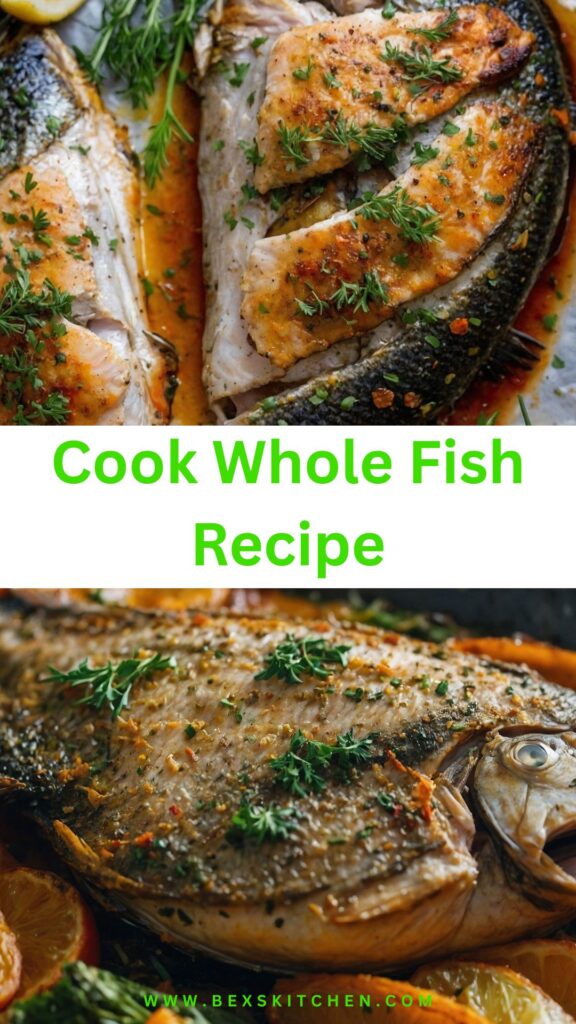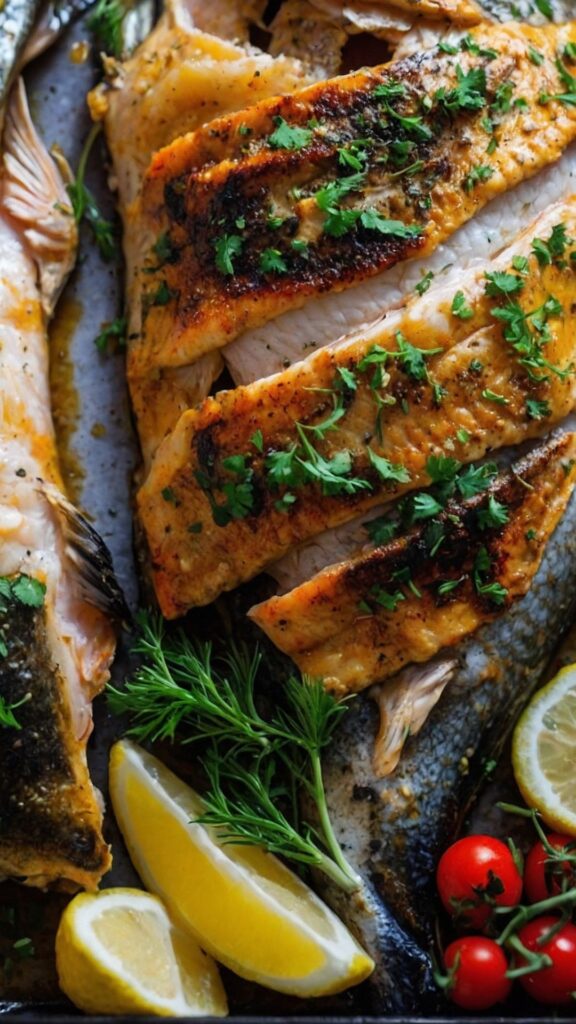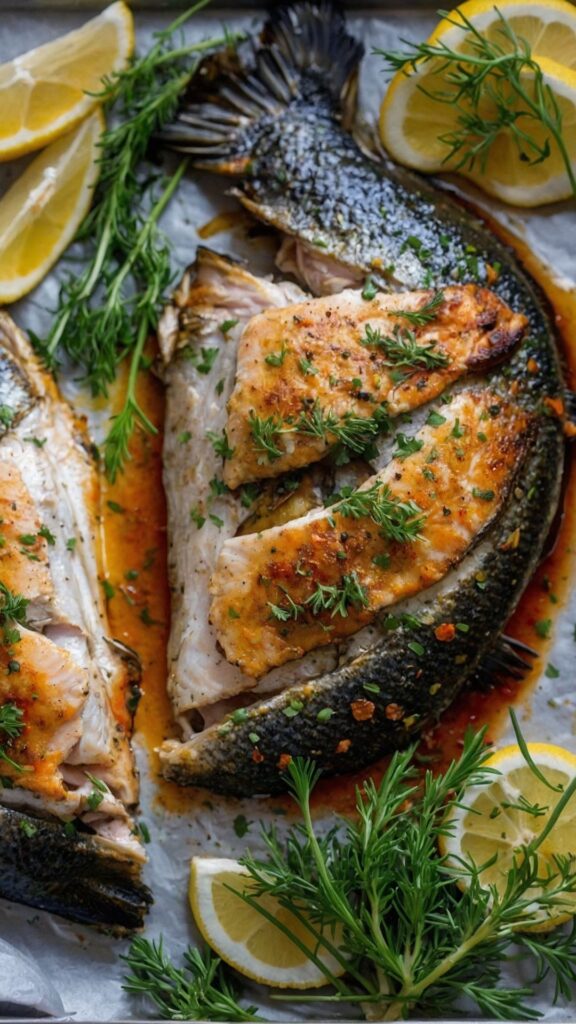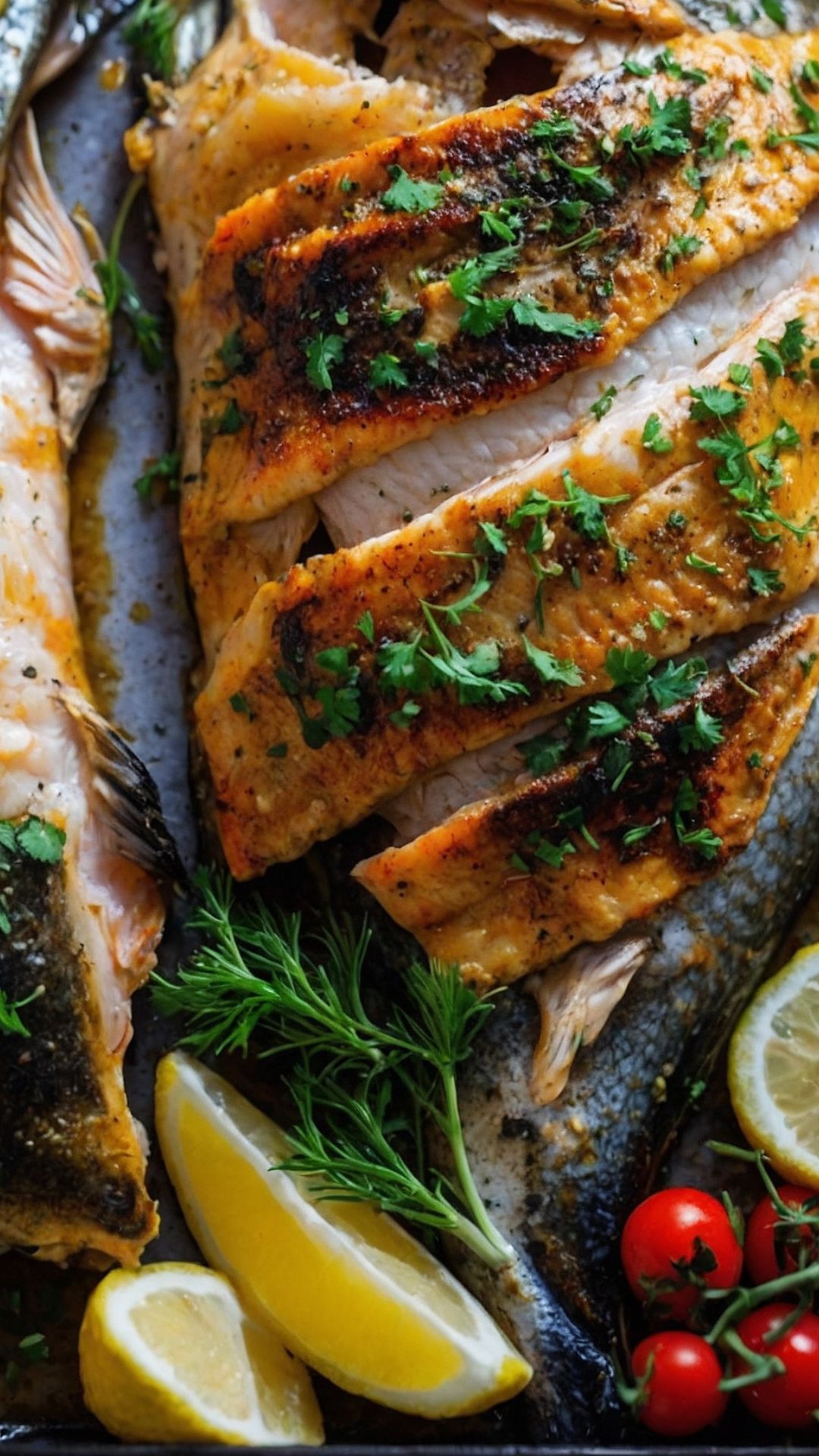When contemplating the humble yet glorious whole fish, think about what complements it best. Begin with a bright, zesty salad alongside it. Something like a classic Italian pasta salad, bursting with colorful veggies and a refreshing dressing can balance the fish’s rich flavors beautifully. Grilled vegetables sprinkled with fresh herbs work wonders, too. Lightly charred zucchini, bell peppers, or asparagus can elevate your dish. Don’t forget about good bread! A crusty sourdough or focaccia is perfect for soaking up any juices.
If you’re feeling adventurous, consider a bed of aromatic rice pilaf. The subtle spices will enhance the fish without overpowering. Wine aficionados might enjoy pairing it with a crisp white wine, such as Sauvignon Blanc. Now, let’s dive into the delectable process of cooking whole fish!

Making Whole Fish a Star of Your Table
Cooking a whole fish may seem intimidating. Trust me, the first time I tackled this task, my hands trembled a bit. The idea of staring into the eyes of my dinner made me second-guess my choices. But as it turned out, it was far simpler and more rewarding than I imagined. My affection for cooking has taught me that everything starts with a good story—and this cooking method is no exception.
Not only is cooking fish whole a fantastic way to showcase its natural flavors, but it’s also an experience. The aroma wafts through the kitchen, acting like a siren’s call. Families gather around the table, excited and hungry. After a long day, this brings us together. It’s an art form that merges culinary skill with cozy home vibes.
What is Cooking Whole Fish?
Cooking whole fish involves preparing the entire fish instead of filleting it. The process encourages moisture retention during cooking, leading to tender and flavorful results. Whether you’re grilling, baking, or pan-searing, cooking whole adds depth to the dish. Fish like snapper, trout, and branzino are excellent candidates for this method.
This traditional practice dates back centuries in various cultures worldwide. The Mediterranean and Asia are particularly known for it, celebrating fish both for its taste and nutritional benefits. Plus, an entire fish on the table fosters a communal dining experience. I still fondly remember the first whole fish meal I witnessed prepared by my grandmother. The ease and joy of sharing a meal this way makes it a winning approach.
What is the Flavor Profile of Whole Fish?
The flavor of whole fish is unique and complex. Depending on the type of fish, taste can range from mild and slightly sweet to firm and rich. Firm white fish, like snapper, has a delicate flavor that’s enhanced when cooked whole. The skin crisps beautifully, providing a delightful contrast to the tender flesh beneath. Add herbs and lemon slices into the cavity, and you inject brightness into the dish.
When you season the fish with salt and spices, every bite bursts with flavor. The natural oils in the fish also contribute to mouthwatering richness. Plus, cooking whole means the meat stays moist, highlighting its fresh taste. Your palate will dance with every forkful, mingling the savory and subtle sweetness that only a whole fish can deliver.
You will also like the following Dinner recipes!
Why You’ll Love Cooking Whole Fish
If the prospect of cooking whole fish doesn’t excite you yet, consider these advantages:
1. Flavor Explosion: The methodology locks in moisture and flavor.
2. Visual Appeal: Nothing says “dinner is special” quite like a beautifully presented whole fish.
3. Simplicity: It requires fewer steps than filleting; more time for you to enjoy your gathering.
4. Nutritional Powerhouse: Whole fish is packed with protein, omega-3 fatty acids, and vital minerals.
5. Cost-Effective: Purchasing whole fish often saves you money compared to fillets.
Ingredients
Gathering quality ingredients is key to any dish, especially when preparing whole fish. Here’s what you’ll need:
Fish:
- 2 whole snapper (about 800 g / 1.6 lb each), scaled, gutted, and cleaned
- 1 tsp lemon zest (to brighten the flavors)
- ½ tsp freshly ground black pepper
- 2 tbsp high-quality extra-virgin olive oil
- 1½ tsp coarse kosher salt (steer clear of fine table salt)
Stuffing:
- 4 garlic cloves, thinly sliced
- 1 lemon, cut into 8 thin rounds
- 2 tbsp thinly sliced green onion (a mild flavor boost)
- ½ cup fresh dill fronds, lightly packed
- ½ cup flat-leaf parsley leaves, lightly packed
Dill-Garlic Butter:
- 1 tbsp finely chopped fresh dill
- 150 g / 10 tbsp unsalted butter, cubed and slightly softened
- 2 tsp garlic, finely minced

Step-by-Step Instructions
Cooking whole fish is a straightforward process. Let’s walk through it step by step.
Step 1: Prepare the Fish
Rinse your fish under cold water. Pat them dry with paper towels. A dry surface ensures nice browning during cooking. Then, make three slashes on each side of the fish. This helps the seasoning penetrate more effectively.
Step 2: Season Generously
Now, place the fish on a large cutting board. Rub the outside of the fish with olive oil, and sprinkle both the inside and outside with salt and pepper. Remember the acidity from lemon zest? You’ll want to sprinkle it on the surface as well.
Step 3: Stuff the Fish
Insert the sliced garlic, lemon rounds, green onion, dill, and parsley into the cavity of each fish. This infusion will elevate the flavor while cooking.
Step 4: Create the Dill-Garlic Butter
In a small bowl, mix the softened butter with chopped dill and minced garlic. Once combined, spread this mixture over the stuffed fish, ensuring it evenly coats the flesh.
Step 5: Cook the Fish
Now it’s time to get cooking! You can opt for various methods: grill, roast, or pan-sear. Place the fish on a grill or baking dish and cook at 375°F (190°C) for about 20-30 minutes, depending on the size. You want the flesh to be opaque and flake easily with a fork.
Step 6: Serve with Intention
Once finished, remove the fish from the grill or oven. A burst of fragrant aroma fills your kitchen. Remove the stuffing and serve the fish on a platter. Garnish with extra herbs and lemon slices for an appealing presentation.
Tips & Tricks
Consider these pro tips to achieve restaurant-worthy results at home:
Choose Fresh Fish: Freshness is your best friend when it comes to cooking whole fish. Check for bright eyes, clear skin, and a mild ocean aroma.
Keep it Simple: Let the quality of your fish shine. Over-seasoning can mask its natural flavor.
Use a Meat Thermometer: To be sure it’s cooked through, check that thickest part of the fish reaches 145°F (63°C).
Avoid Overcooking: Fish cooks quickly. Keep an eye on the timing to ensure it remains tender and moist.
Experiment with Botanicals: You can play around with the stuffing. Consider using fennel, thyme, or even citrus fruits based on your cravings.
Nutrition Information
Here’s a quick breakdown of the nutritional value per serving of this whole fish dish:
This dish is an incredible source of lean protein and heart-healthy fats. Pair it with plenty of colorful veggies to round out your meal and add fiber.

Storing Cooked Whole Fish
Sometimes, leftovers happen. If you have extra fish, store it properly to maintain its flavor.
- Refrigerate: Place the cooled fish in an airtight container and refrigerate for up to 2 days.
- Freeze: For longer storage, freeze portions in vacuum-sealed bags or wrap tightly in plastic wrap and then foil. It can last up to three months in the freezer.
Be sure to reheat gently to prevent drying it out. A quick steam or low oven gradual warm-up works wonders.
Alternative Ingredients
If some ingredients are elusive, don’t worry! Here are alternative options you can consider:
- Fresh Herbs: If you can’t find dill or parsley, try basil or cilantro instead. Both add a different yet delightful flavor kick.
- Fish Type: If snapper is not available, consider using trout or branzino. Both offer similar textural and taste qualities.
- Butter Alternative: Prefer a dairy-free approach? Swap unsalted butter for coconut oil or vegan butter. It creates a unique mouthfeel without compromising flavor.

Equipment
- Preheated oven
- Mixing bowl
Ingredients
Fish:
- 2 whole snapper about 800 g / 1.6 lb each, scaled, gutted, and cleaned
- 1 tsp lemon zest to brighten the flavors
- ½ tsp freshly ground black pepper
- 2 tbsp high-quality extra-virgin olive oil
- 1½ tsp coarse kosher salt steer clear of fine table salt
Stuffing:
- 4 garlic cloves thinly sliced
- 1 lemon cut into 8 thin rounds
- 2 tbsp thinly sliced green onion a mild flavor boost
- ½ cup fresh dill fronds lightly packed
- ½ cup flat-leaf parsley leaves lightly packed
Dill-Garlic Butter:
- 1 tbsp finely chopped fresh dill
- 150 g / 10 tbsp unsalted butter cubed and slightly softened
- 2 tsp garlic finely minced
Instructions
Step 1: Prepare the Fish
- Rinse your fish under cold water. Pat them dry with paper towels. A dry surface ensures nice browning during cooking. Then, make three slashes on each side of the fish. This helps the seasoning penetrate more effectively.
Step 2: Season Generously
- Now, place the fish on a large cutting board. Rub the outside of the fish with olive oil, and sprinkle both the inside and outside with salt and pepper. Remember the acidity from lemon zest? You’ll want to sprinkle it on the surface as well.
Step 3: Stuff the Fish
- Insert the sliced garlic, lemon rounds, green onion, dill, and parsley into the cavity of each fish. This infusion will elevate the flavor while cooking.
Step 4: Create the Dill-Garlic Butter
- In a small bowl, mix the softened butter with chopped dill and minced garlic. Once combined, spread this mixture over the stuffed fish, ensuring it evenly coats the flesh.
Step 5: Cook the Fish
- Now it’s time to get cooking! You can opt for various methods: grill, roast, or pan-sear. Place the fish on a grill or baking dish and cook at 375°F (190°C) for about 20-30 minutes, depending on the size. You want the flesh to be opaque and flake easily with a fork.
Step 6: Serve with Intention
- Once finished, remove the fish from the grill or oven. A burst of fragrant aroma fills your kitchen. Remove the stuffing and serve the fish on a platter. Garnish with extra herbs and lemon slices for an appealing presentation.
Notes
- Choose Fresh Fish: Freshness is your best friend when it comes to cooking whole fish. Check for bright eyes, clear skin, and a mild ocean aroma.
- Keep it Simple: Let the quality of your fish shine. Over-seasoning can mask its natural flavor.
- Use a Meat Thermometer: To be sure it’s cooked through, check that thickest part of the fish reaches 145°F (63°C).
- Avoid Overcooking: Fish cooks quickly. Keep an eye on the timing to ensure it remains tender and moist.
- Experiment with Botanicals: You can play around with the stuffing. Consider using fennel, thyme, or even citrus fruits based on your cravings.
Nutrition
Frequently Asked Questions
1. How do I know when the whole fish is done cooking?
The best indicator is the flesh. It should appear opaque and flake easily with a fork. A meat thermometer can ensure it’s cooked through to 145°F (63°C).
2. Can I cook whole fish on a stovetop?
Absolutely! A large skillet or cast-iron pan works well. Just make sure it’s hot enough to sear the skin nicely.
3. What’s the best method for cooking whole fish?
That depends on your preferences! Grilling lends smokiness, while baking leads to tenderness. Both are excellent choices.
4. Is cooking whole fish more sustainable?
Yes! Utilizing the whole fish reduces waste and promotes a responsible approach to seafood consumption.
5. Can I serve the fish cold?
Certainly! Whole fish can be enjoyed at any temperature. Cold fish can make a refreshing addition to salads or as an appetizer.
Conclusion
Cooking whole fish may seem daunting at first, but it’s truly an art that offers as much enjoyment as it does culinary satisfaction. The flavors, the presentation, and the communal experience all contribute to something special. Remember, whether for family dinners or summer barbecues, whole fish stands out. By engaging your ingredients, paying attention to the cooking process, and embracing creativity, you can master this delightful dish.
The next time you plan a gathering, consider preparing a whole fish. You’ll not only impress your guests, but you’ll also elevate your dinner game. Happy cooking, and enjoy every bite!
